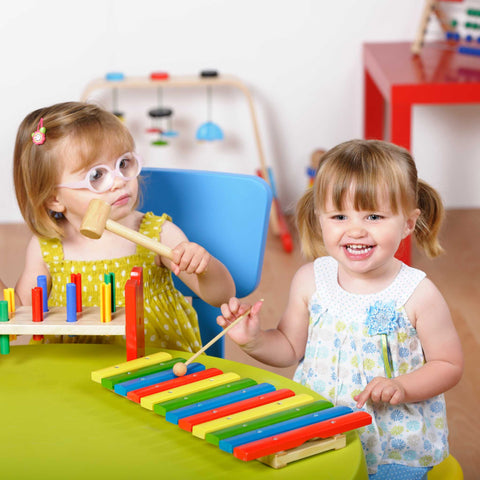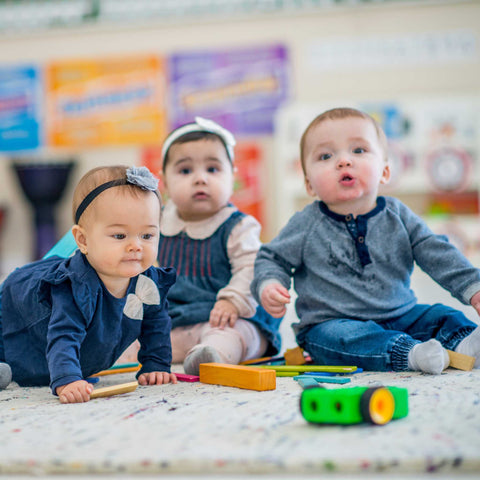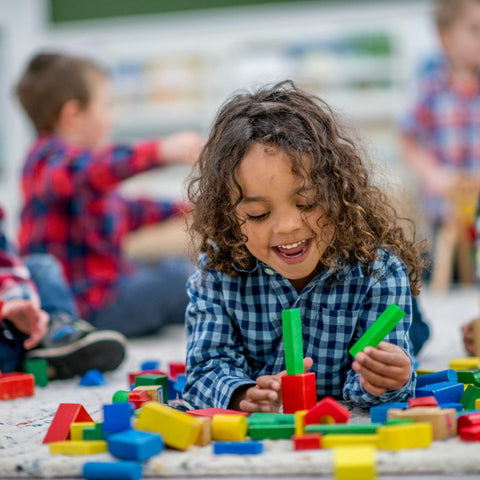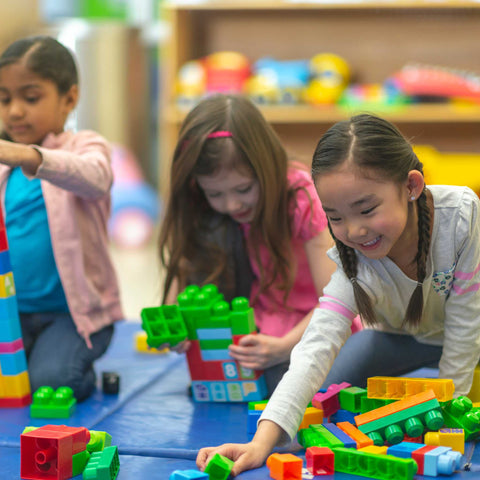The Joy and Freedom of Unstructured Play
Welcome to the wonderful world of unstructured play, a magical realm where children lead their adventures, free from detailed instructions and rigid rules. Unlike structured play, which typically follows a set pattern or guidance from adults, unstructured play springs from a child's imagination and curiosity.
It's spontaneous, led by the child, and incredibly versatile, adapting to swings at the park, dress-up sessions at home, or building a fort from cushions.
The value of unstructured play in child development cannot be overstated. It's not just about having fun; it's a critical component of learning and growth. This type of play nurtures creativity, encourages problem-solving skills, and builds social and emotional strength—foundations that support a child's ability to thrive in varied situations.
As we dive deeper, we'll explore how letting children play freely can dramatically enhance their cognitive, physical, and emotional well-being, setting them up for success in every stage of life. Join us as we unpack why every child deserves time to play without boundaries and how this fundamental activity can lead to profound developmental benefits.
Understanding Unstructured Play
Definition and Examples of Unstructured Play
Unstructured play, often referred to as free play, is any kind of play that arises naturally from a child’s instincts and imagination without preset rules or directions. This can include activities like creating make-believe worlds, constructing shapes out of play-dough, or simply running freely at the park. The key component? It's all initiated and led by the child, offering a pure form of expression and exploration of their own interests.
Structured vs Unstructured Play
While structured play is designed with a specific learning objective in mind, facilitated by toys or led by adults, like a teacher-led craft project or a sports game with formal rules, unstructured play stands on the other side of the spectrum.
It doesn’t push children towards a particular outcome but instead encourages them to set their own goals and explore in ways that feel natural to them. This freedom is crucial as it lets kids learn how to make decisions, solve problems creatively, and engage socially on their own terms. In unstructured play, the process is valued more than the end product, allowing children to develop skills at their own pace in a stress-free environment.
The Benefits of Unstructured Play

Cognitive Development
Unstructured play is a powerful tool in nurturing a child's cognitive abilities. It fosters creativity as children explore, create, and experiment in a setting without guidelines or expectations.
This type of play also sharpens problem-solving skills and decision-making abilities by presenting kids with opportunities to find solutions to challenges they create or encounter during play. The freedom to choose and direct their activities reinforces cognitive pathways related to planning and execution, which are critical in cognitive development.
Physical Benefits
From climbing trees to building forts, unstructured play often involves a variety of physical activities that are crucial for developing strong bones, good muscle tone, coordination, and agility. This kind of play naturally encourages children to move, jump, run, and dance, thereby improving their physical health and motor skills without the structured environment of traditional sports or physical education.
The spontaneity involved keeps children active and engaged, which can contribute to long-term habits of regular exercise.
Emotional and Social Development
Unstructured play offers a unique platform for children to express their emotions and learn how to manage them. By interacting with peers in an unstructured environment, children learn valuable social skills such as negotiation, cooperation, and sharing.
They practice resolving conflicts, leading activities, and following others, which enhances their social competence and emotional maturity. This kind of play supports children in developing empathy and understanding different perspectives, laying the groundwork for healthier social interactions as they grow.
Imagination and Independence
When children engage in unstructured play, they delve into a world of imagination where anything is possible. This form of play does not limit their choices to predefined rules or outcomes, which encourages innovative thinking and creativity.
Such an environment allows children to experiment with various scenarios, roles, and ideas, boosting their confidence and independence. As they make choices and face the outcomes of those choices, they learn to stand on their own, think independently, and trust in their abilities to direct their actions and ideas.
Unstructured play is not just about letting children "just be kids"—it is a vital component of their development that benefits their minds, bodies, and social interactions. By promoting such play, we provide our children with the essential tools to thrive in every aspect of their lives.
Unstructured Play Across Different Ages

Unstructured Play for Toddlers
For toddlers, unstructured play often revolves around exploring their immediate environment, which is a vital aspect of their developmental process. At this stage, play is about touching, tasting, and testing the physical world around them.
Whether it’s stacking blocks, playing in the sand, or drawing with crayons, these activities are crucial for their sensory development and motor skills. This kind of play allows toddlers to establish a sense of autonomy and learn the basic mechanics of cause and effect, which are foundational elements of cognitive growth.
Unstructured Play for Preschoolers
As children grow into the preschool age, unstructured play begins to take on more complex forms and is crucial for boosting their emerging problem-solving skills and creativity. Preschoolers engage in role-playing, make-believe scenarios, and arts and crafts, which allow them to express themselves and process their understanding of the world. This type of play enhances their language skills and begins to lay the groundwork for effective communication and socialization, as they start to play more collaboratively with peers and negotiate their roles and rules in play scenarios.
Unstructured Play for School-aged Children
For school-aged children, unstructured play becomes more about complex games, building projects, and sports that they organize on their own, like pick-up games of soccer or a neighborhood game of hide and seek. This type of play is critical not only for continuing physical development and coordination but also for fostering leadership skills and teamwork.
It provides an essential counterbalance to the structured environments of school and organized activities, giving older children the freedom to manage their leisure time and further develop a sense of independence and self-confidence.
Unstructured play evolves with children as they grow, but its core benefits remain. It is a fundamental part of childhood that nurtures independence, creativity, and overall well-being across all age groups, adapting to meet their developmental needs as they progress from toddlers to preschoolers to school-aged children. Each stage of unstructured play builds upon the last, ensuring that children develop a robust foundation of skills that will support their academic learning and personal growth.
Guidelines for Unstructured Play
How Much Is Needed
The amount of unstructured playtime children need can vary by age, but as a general guideline, toddlers may thrive with several hours of play each day, while older children benefit from at least one to two hours. Pediatric experts often emphasize the importance of balancing structured activities with ample time for free play to ensure a healthy development.
For toddlers, this means interspersing more structured activities with periods of free exploration. For older children, ensuring they have time after school and on weekends to explore their own interests and play independently can be very beneficial.
Creating the Right Environment
Creating a conducive environment for unstructured play is essential for nurturing your child’s creativity and independence. For indoor play, ensure there are safe, open spaces where children can explore and play without too many restrictions. Incorporating diverse materials like blocks, dolls, art supplies, and dress-up clothes can spark imaginative play.
For outdoor play, spaces that are safe yet offer elements of nature, like sand, water, and diverse terrain, encourage physical activity and interaction with the environment. Always supervise play to ensure safety, but try to stay hands-off to let your child’s creativity flourish.
These guidelines are designed to help parents understand the flexible nature of unstructured play and the importance of adapting play opportunities to suit the developmental stage and interests of their child. By providing the right amount of time and an encouraging environment, you can significantly enhance your child’s ability to learn through play, fostering skills that will benefit them throughout their lives.
Challenges and Solutions

Common Challenges
Parents often worry about safety, the mess created during play, and the educational value of unstructured play. It's important to recognize that while unstructured play can sometimes be messy, this mess is a crucial part of how children learn and explore their creativity.
To manage safety concerns, ensure that the play environment is secure by childproofing and removing any hazardous materials, allowing children to explore freely within a safe boundary. Regarding the educational value, remember that unstructured play fosters critical thinking, problem-solving, and independence, which are vital components of learning.
Balancing Screen Time
In today’s digital age, balancing screen time with physical play is a significant challenge.
To encourage more unstructured play, set clear limits on screen time based on your child’s age and needs. Encourage offline activities that are equally engaging and fun, such as art projects, building blocks, or imaginative games. Make unstructured play a part of your daily routine, perhaps by scheduling it before or after screen time, to ensure it becomes a habit.
You might also lead by example: engage in your own screen-free hobbies during this time to show your child that valuable and enjoyable activities exist outside of digital devices.
These strategies aim to help parents navigate the complexities of facilitating unstructured play while addressing common concerns. By creating a balance and setting the right expectations, parents can maximize the benefits of unstructured play, making it a fulfilling part of their child’s daily life.
Encouraging Unstructured Play
Facilitating Free Play
Encouraging unstructured play starts with stepping back. Offer a variety of open-ended toys—like blocks, dolls, and art supplies—that don't dictate how they're used, allowing your child to exercise creativity. Resist the urge to direct the play; instead, be available to participate if invited.
Ask open-ended questions like, "Tell me about what you're building," to engage without leading. This approach helps children feel supported in their exploration while nurturing their ability to create and dictate their own play.
Integrating Play into Daily Routines
Incorporating unstructured play into your child’s daily life can be as simple as setting aside specific times each day for open-ended activities. This could be after homework and before dinner or first thing in the morning before the day's routines begin.
Ensure these playtimes are free from interruptions like television or scheduled activities to provide a real opportunity for spontaneous play. Additionally, consider creating spaces in your home dedicated to unstructured play. Whether it’s a corner of the living room or a part of your child’s bedroom, having a dedicated space can encourage regular engagement in creative play.
By creating environments that inspire play and carving out time in the busy daily schedule, parents can greatly enhance their child's development through unstructured play. These steps not only support a child's creativity and independence but also integrate essential playtime into their everyday life, establishing a healthy balance between guided activities and free play.
Embracing the Magic of Unstructured Play

A Foundation for Growth
Unstructured play isn't just another way to pass the time; it's a vital part of childhood that nurtures a range of developmental skills.
From sparking creativity and bolstering physical abilities to enhancing social skills and emotional understanding, the benefits of unstructured play touch every facet of a child's growth. It encourages children to explore, imagine, and create, providing a strong foundation for learning and development that structured activities alone cannot offer.
Embrace the Chaos
As parents, embracing the chaos and mess that often comes with unstructured play is essential. Prioritize and protect this playtime as you would any other important activity in your child’s life. Remember, when children are left to play on their own terms, they not only learn about the world around them but also about themselves. Encourage this exploration, and watch as your child flourishes both in play and in life. Let’s make room for unstructured play every day, understanding its profound impact on our children’s development and happiness.
Join the Conversation on Unstructured Play
Share and Learn Together
We'd love to hear how you incorporate unstructured play into your child's daily routine! Share your experiences and tips in the comments below or connect with us on social media.
Let's exchange ideas and inspire each other to create more playful opportunities for our kids.
Your insights and strategies are invaluable. Join the discussion on our social platforms and help us explore further the transformative impact of unstructured play on child development. Together, we can support each other in nurturing more creative, independent, and joyful learners.
Leave your comments below; we love to hear from you! And don't forget to follow Easy Peasie for more veggie info and convo on YouTube, Facebook, and Instagram! ~ThePeas













